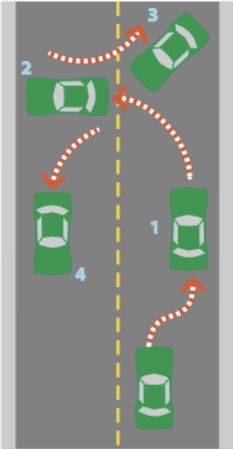Session 13 – Rules About Traffic Lanes
GENERAL RULES ABOUT TRAFFIC LANES
When there are no signs or markings to control the use of lanes, there are rules that indicate which lane is to be used. These rules cover general driving, passing and turning.
General driving. It is illegal and unsafe to back a vehicle in any travel lane unless you are parallel parking or completing a Y-turn. Drivers do not expect a vehicle to be backing toward them and may not realize it until it is too late. If you miss your turn or exit on a freeway, do not back up. Go on to the next exit where you can exit and re-enter the freeway to go back to the exit you missed.
Do not stop in travel lanes for any reason (confusion, breakdowns, letting out a passenger). Keep moving until you can safely pull off the road.
On a road with two or more lanes traveling in the same direction, stay in the right lane except to pass. On a road with three or more lanes traveling in the same direction, stay as far to the right as practical.
As a general rule, never drive on an unpaved shoulder of the road.
Passing. You should never pass on the shoulder. However, a paved shoulder may be used to pass a stopped vehicle or one that is slowing to make a left turn. On multi-lane roads, the left-most lane is intended to be used for passing slower vehicles. If you pass on the right, the other driver may have difficulty seeing you and might suddenly change lanes in front of you.
TURNING
The safest way to make turns is to go from one travel lane to the other as directly as possible without crossing lane lines or interfering with other traffic. Once you have completed your turn, you can change to another lane if you need to.
Do not drive in a reserved lane. Reserved lanes or those marked for parking, or restricted to buses, bicycles, or marked for turns only are not travel lanes except for buses or bicycles. You should only drive in them when you are within half a block of where you plan to turn.
If you start turning at an intersection, do not change your mind about turning. Last second changes can cause a crash. Complete your turn and go on to the next intersection where you can turn and work your way back to where you want to go.
Multiple turn lanes. If there are signs or lane markings that allow for two or more turning lanes, stay in your lane during the turn.
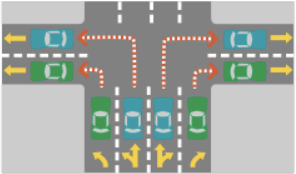
Right turns. After checking traffic to the rear and signaling, move into the travel lane farthest to the right. Before starting to turn, look right and left. Remember to yield the right-of-way, if necessary. Move your vehicle around the corner and into the travel lane farthest to the right.
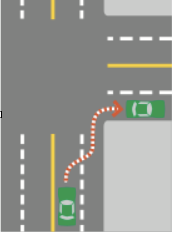
Do not swing wide as shown in the examples.
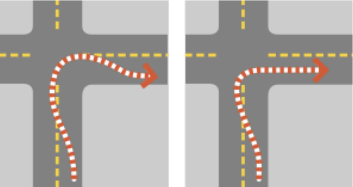
Avoid swinging wide to the left before starting to make the turn. If you swing wide, the driver behind you may think you are changing lanes or going to turn left and may try to pass you on the right. If you swing wide as you complete the turn, drivers who are in the far lane will not expect to see you there.
Caution: Watch for large trucks and buses making right turns. In order to make the turn, they may need to swing left before turning right. Do not attempt to pass these vehicles on the right.

Left turns. On a left turn or U-turn, turn into the travel lane farthest to the left going in your direction; (See Figures 1-4 for examples of the lanes to use when making a left turn.) This way, you will cross the fewest lanes of traffic.

After checking traffic to the rear and signaling, move into the turn lane (if there is one) or the travel lane farthest to the left. Before starting to turn, look left, right, across the intersection, then left again. Remember to yield the right-of-way, if necessary.
Pull out toward the midpoint of the intersection (See center dot in Figure 5.) Wait, with wheels straight, until it is clear to turn. If the traffic light turns red, complete the turn when it is safe. Keep just left of the midpoint (center dot in Figure 5) of the intersection as you turn.
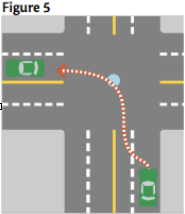
Don’t turn the wheels while you are waiting to make a left turn or U-turn. If your wheels are turned and you are hit from behind, you could be pushed into oncoming traffic.
Be sure to leave room for oncoming vehicles to turn left in front of you. (See Figure 6.)

Be aware of traffic approaching on your left. When you make a left turn, avoid cutting the corner so sharply that you run into traffic approaching on your left. When you make a U-turn, watch for cars turning right-on-red that may not watch for you and yield as they should.
U-Turn
A U-turn is a turn within the road, made in one smooth U-shaped motion, so as to end up traveling in the opposite direction.
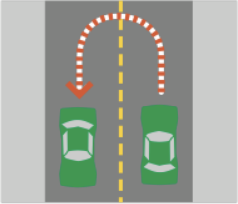
You may not make a U-turn:
- At any intersection where a police officer is controlling traffic unless the officer instructs you to make a U-turn.
- In mid-block on any street in a business district or in mid-block on a through (main) highway in a residential district, except where the street or highway is divided and the turn is made at a legal opening or crossover.
- At any place where signs prohibit such turns.
- Upon a curve or upon the approach to or near the crest of a grade on any undivided highway where the vehicle cannot be seen by the driver of any other vehicle with 500 feet approaching from any direction.
- At any place where a U-turn cannot be made safely or without interfering with other traffic.
Y-Turn
This is used in the driving exam as a test of skill and judgment. It is not recommended for use in general driving, but may be used in residential areas on streets too narrow for a U-turn.
How to Make a Y-Turn
- Check for traffic in your mirrors and blind spot. Signal right. Pull as far right as possible and stop.
- Check traffic in mirrors and blind spot. When the way is clear, signal left. Make a left-angle turn to the opposite curb or side of the road.
- Check traffic to left and right. Turn front wheels as far right as possible. Looking behind the vehicle, back far enough so the vehicle clears the curb when you pull forward.
- Check traffic to left and right and proceed when the way is clear.
